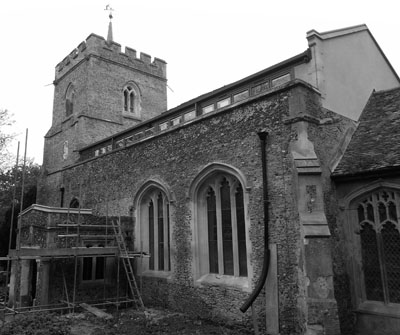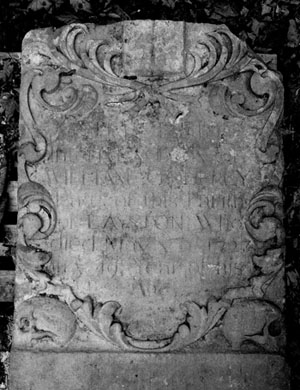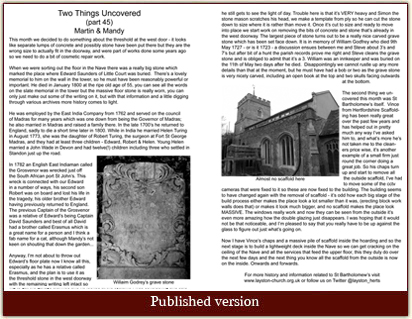Martin & Mandy

This month we decided to do something about the threshold at the west door - it looks like separate lumps of concrete and possibly stone have been put there but they are the wrong size to actually fit in the doorway, and were part of works done some years ago so we need to do a bit of cosmetic repair work.
When we were sorting out the floor in the Nave there was a really big stone which marked the place where Edward Saunders of Little Court was buried. There's a lovely memorial to him on the wall in the tower, so he must have been reasonably powerful or important. He died in January 1800 at the ripe old age of 55, you can see all the words on the slate memorial in the tower but the massive floor stone is really worn, you can only just make out some of the writing on it, but with that information and a little digging through various archives more history comes to light.
He was employed by the East India Company from 1762 and served on the council of Madras for many years which was one down from being the Governor of Madras; he also married in Madras and raised a family there. In the late 1700's he returned to England, sadly to die a short time later in 1800. While in India he married Helen Turing in August 1773, she was the daughter of Robert Turing, the surgeon at Fort St George Madras, and they had at least three children - Edward, Robert & Helen. Young Helen married a John Wade in Devon and had twelve(!) children including three who settled in Standon just up the road.
In 1782 an English East Indiaman called the Grosvenor was wrecked just off the South African port St John's. This wreck is connected with our Edward in a number of ways, his second son Robert was on board and lost his life in the tragedy, his older brother Edward having previously returned to England. The previous Captain of the Grosvenor was a relative of Edward's being Captain David Saunders and best of all David had a brother called Erasmus which is a great name for a person and I think a fab name for a cat, although Mandy's not keen on shouting that down the garden...
Anyway, I'm not about to throw out Edward's floor plate now I know all this, especially as he has a relative called Erasmus, and the plan is to use it as the threshold stone in the west doorway with the remaining writing left intact so he still gets to see the light of day. Trouble here is that it's VERY heavy and Simon the stone mason scratches his head, we make a template from ply so he can cut the stone down to size where it is rather than move it. Once it's cut to size and ready to move into place we start work on removing the bits of concrete and stone that's already in the west doorway.

The largest piece of stone turns out to be a really nice carved grave stone which has been set face down. It is in memory of William Godfrey who died 9th May 1727 - or is it 1723 - a discussion ensues between me and Steve about 3's and 7's but after bit of a hunt the parish records prove me right and Steve cleans the grave stone and is obliged to admit that it's a 3. William was an innkeeper and was buried on the 11th of May two days after he died. disappointingly we cannot rustle up any more details than that at the moment, but he must have had a bob or two as the grave stone is very nicely carved, including an open book at the top and two skulls facing outwards at the bottom.
The second thing we uncovered this month was St Bartholomew's itself. Vince from Hertfordshire Scaffolding has been really great over the past few years and has helped out in pretty much any way I've asked him to, and what's more he's not taken me to the cleaners price wise, it's another example of a small firm just round the corner doing a great job. So his chaps turn up and start to remove all the outside scaffold, I've had to move some of the cctv cameras that were fixed to it so these are now fixed to the building. The building seems to have changed again with the removal of scaffold - it's odd how each big stage of the build process either makes the place look a lot smaller than it was, (erecting block work walls does that) or makes it look much bigger, and no scaffold makes the place look MASSIVE. The windows really work and now they can be seen from the outside it's even more amazing how the double glazing just disappears. I was hoping that it would not be that noticeable, and I'm pleased to say that you really have to be up against the glass to figure out just what's going on,
Now I have Vince's chaps and a massive pile of scaffold inside the hoarding and so the next stage is to build a lightweight deck inside the Nave so we can get cracking on the ceiling of the Nave and all the services that feed the upper floor, this they duly do over the next few days and the next thing you know all the scaffold from the outside is now on the inside. Onwards and forwards.
For more history and information related to St Bartholomew's visit www.layston-church.org.uk or follow us on Twitter @layston_herts

 |
|
 |

